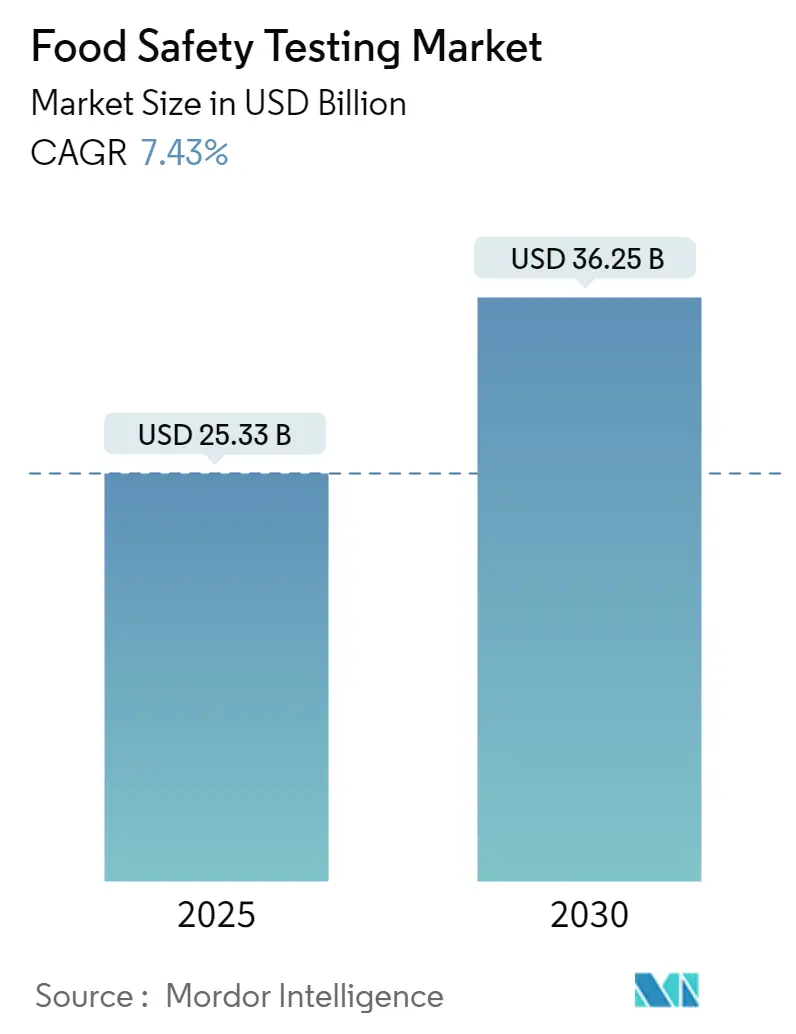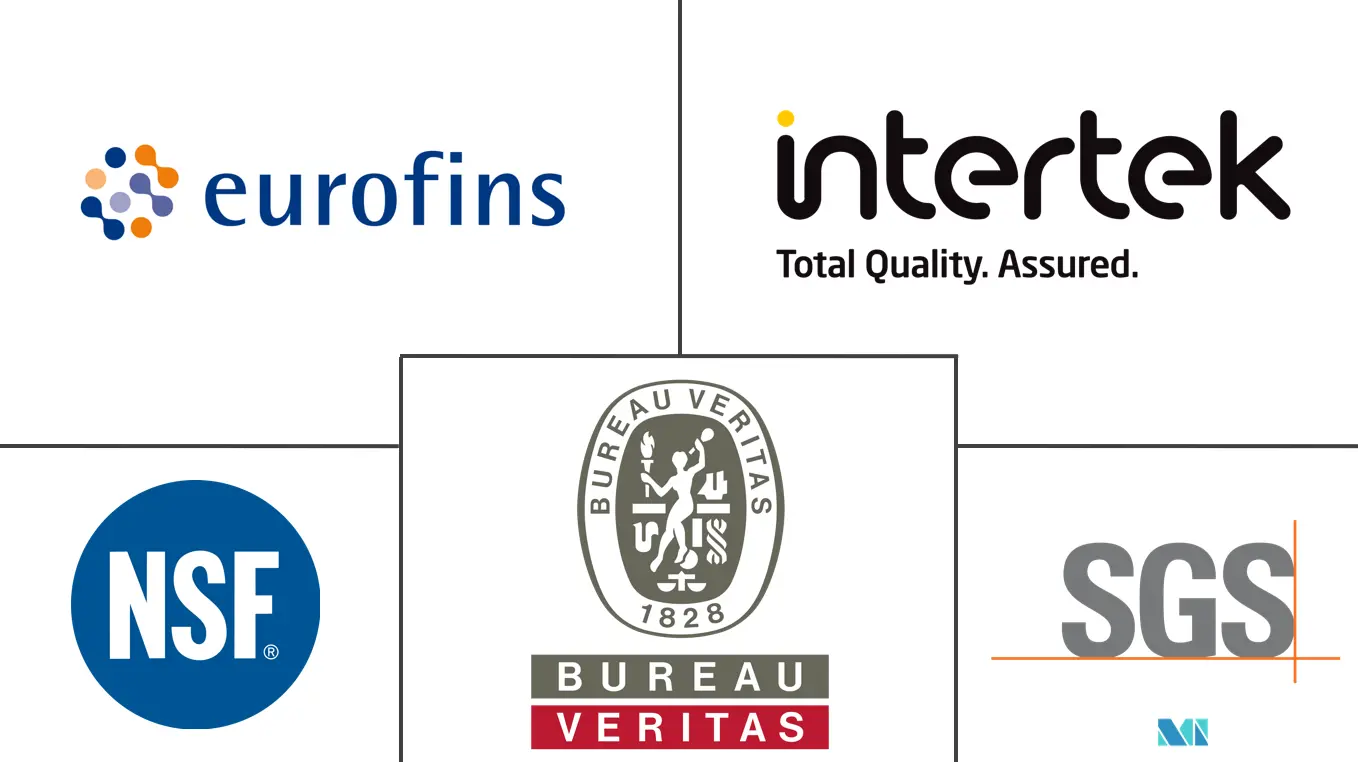| Study Period | 2019 - 2030 |
| Market Size (2025) | USD 25.33 Billion |
| Market Size (2030) | USD 36.25 Billion |
| CAGR (2025 - 2030) | 7.43 % |
| Fastest Growing Market | Middle East and Africa |
| Largest Market | Europe |
| Market Concentration | Low |
Major Players*Disclaimer: Major Players sorted in no particular order |
Food Safety Testing Market Analysis
The Food Safety Testing Market size is estimated at USD 25.33 billion in 2025, and is expected to reach USD 36.25 billion by 2030, at a CAGR of 7.43% during the forecast period (2025-2030).
The food safety testing industry is experiencing a technological revolution with the integration of artificial intelligence (AI), machine learning (ML), and blockchain technologies. Leading regulatory bodies like the FDA and FSSAI are actively investing in understanding and implementing these advanced technologies for enhanced food diagnostics. The emergence of food fingerprinting technology, which utilizes spectroscopic and spectrometric data, represents a significant advancement in food authentication and safety verification. This innovative approach enables comprehensive characterization of food matrices and helps detect adulterations through sophisticated analytical techniques.
The industry is witnessing a significant shift toward organic and clean-label products, driving the demand for more comprehensive testing protocols. The European Union maintains stringent regulations with over 500 chemicals and toxic substances that must be absent from organic products exported to European countries. Testing laboratories are expanding their capabilities to meet these requirements, with organizations like Eurofins Scientific now offering more than 200,000 analytical methods and conducting approximately 450 million assays annually to ensure food quality assurance and compliance with regulatory standards.
Laboratory modernization is transforming the food laboratory testing landscape, with facilities adopting advanced analytical tools such as nuclear magnetic resonance (NMR), near-infrared (NIR), and FT-IR spectroscopy. These technologies enable non-destructive, rapid, and direct analysis of food samples, providing simultaneous determination of multiple compounds. The integration of isotope ratio mass spectrometry (IRMS) for food fingerprinting has become increasingly prevalent, allowing for precise identification of geographical origins and authentication of natural ingredients.
The industry is experiencing a paradigm shift in testing methodologies with the adoption of high-throughput screening approaches for sample differentiation and classification. Advanced DNA-based technologies are being increasingly utilized for GMO testing, whole-genome sequencing, and species identification. Testing facilities are implementing cutting-edge analytical tools like UHPLC-MS/MS, GC-MS/MS triple quadrupole, and Orbitrap technologies for fast and accurate contaminant analysis, enabling more precise detection of food adulterations and ensuring higher standards of food safety testing.
Food Safety Testing Market Trends
Growing Consumer Interest in Food Safety and Quality
The increasing prevalence of foodborne diseases globally has heightened consumer awareness and demand for food safety testing. Government organizations like the Codex Alimentarius Commission are implementing comprehensive food safety, quality, and labeling standards while monitoring and enforcing safety protocols through systematic food control activities. In developed nations like the United States, food ingredients classified as additives, including preservatives, emulsifiers, and colors, require stringent government authorization before use in foods. According to Title 21, Part 170 of the US Code of Federal Regulations, manufacturers must provide scientific evidence proving their products' safety, with approval granted only when there is "an assurance that the material is not dangerous within the intended conditions and restrictions."
The globalization of food supply chains has made ensuring food quality assurance increasingly critical within and across countries. Food producers, food agencies, regulatory authorities, and consumers are compelled to adopt hygienic food production practices due to the growing global population and increased awareness of food production cleanliness. This heightened awareness has led to the implementation of more stringent food quality testing standards and testing requirements. Food manufacturers must now comply with extensive safety protocols, including regular testing for contaminants, proper documentation of ingredients, and adherence to international safety standards. The food industry has responded by investing in advanced testing technologies and quality control measures to meet these elevated consumer expectations and regulatory requirements.
Food Safety Testing Emerging as Pivotal Against Surging Food Fraud Cases
The intensifying competition among food manufacturers has resulted in an increase in food fraud cases, leading to deliberate substitution, tampering, misrepresentation of food products, faulty packaging, and misleading statements. According to European Union data, fruits and vegetables accounted for the highest number of food fraud notifications, followed by fish and fish products, highlighting the widespread nature of this issue across different food categories. The deployment of technological tools combined with legal actions has emerged as a potential strategy for combating food fraud, with various initiatives launched by companies and regulatory bodies to identify fraud as early as possible.
The European Knowledge Center for Food Fraud and Quality, working in conjunction with the Joint Research Center, contributes vital expertise in food science to combat fraud. The European Anti-Fraud Office (OLAF) conducts specific investigations in coordination with the Food Fraud Network, while also collaborating with Europol for law enforcement cooperation. These organizations participate in joint operations aimed at detecting and preventing food fraud, demonstrating the increasing importance of coordinated international efforts. Food companies are establishing fraud mitigation strategies in accordance with governmental laws and regulations, such as the Produce Traceability Initiative, which aims to introduce case-level electronic traceability in the fresh produce industry across North America.
High Usage of Pesticides and Growing Policy Focus on Food Safety
The escalating demand for food production has led to increased pesticide usage in agriculture, necessitating rigorous monitoring of residual levels for human health and safety. Agricultural consumption data from major economies shows significant pesticide usage, with the United States recording 407,779.2 tons, China utilizing 273,375.75 tons, and European nations like France consuming 65,216.43 tons annually. This extensive use of agricultural chemicals has prompted regulatory bodies worldwide to implement strict testing protocols and maximum residue limits (MRLs) to ensure food contamination testing. The World Health Organization and Food and Agricultural Organization are actively involved in determining the hazards posed by pesticides through ingestion of residues or direct contact.
The food safety testing market has evolved in response to these challenges, with testing laboratories developing advanced analytical capabilities to detect and quantify pesticide residues. Regulatory agencies worldwide have established comprehensive monitoring programs and safety parameters for various food products. The Food Quality Protection Act, implemented in most countries, enforces safety tests for both new and existing pesticides, with yields assessed to ensure safety limits are maintained at levels that won't affect newborns, children, or adults. This heightened focus on pesticide monitoring has led to the development of more sophisticated food contamination testing methodologies and increased frequency of testing throughout the food production chain, particularly in crops and processed food products.
Segment Analysis: By Contaminant Type
Pathogen Testing Segment in Food Safety Testing Market
The food pathogen testing segment continues to dominate the global food safety testing market, commanding approximately 51% market share in 2024. This significant market position is primarily driven by increasing concerns regarding foodborne illnesses caused by bacteria and virus-causing pathogens. The segment's prominence is further strengthened by the rising number of food safety regulations worldwide that mandate regular food pathogen testing, particularly for common foodborne pathogens like Salmonella, Listeria, and E. coli. Food manufacturers and processors are increasingly investing in comprehensive food bacteria testing protocols to ensure product safety and maintain consumer trust, while also complying with stringent regulatory requirements across different regions.
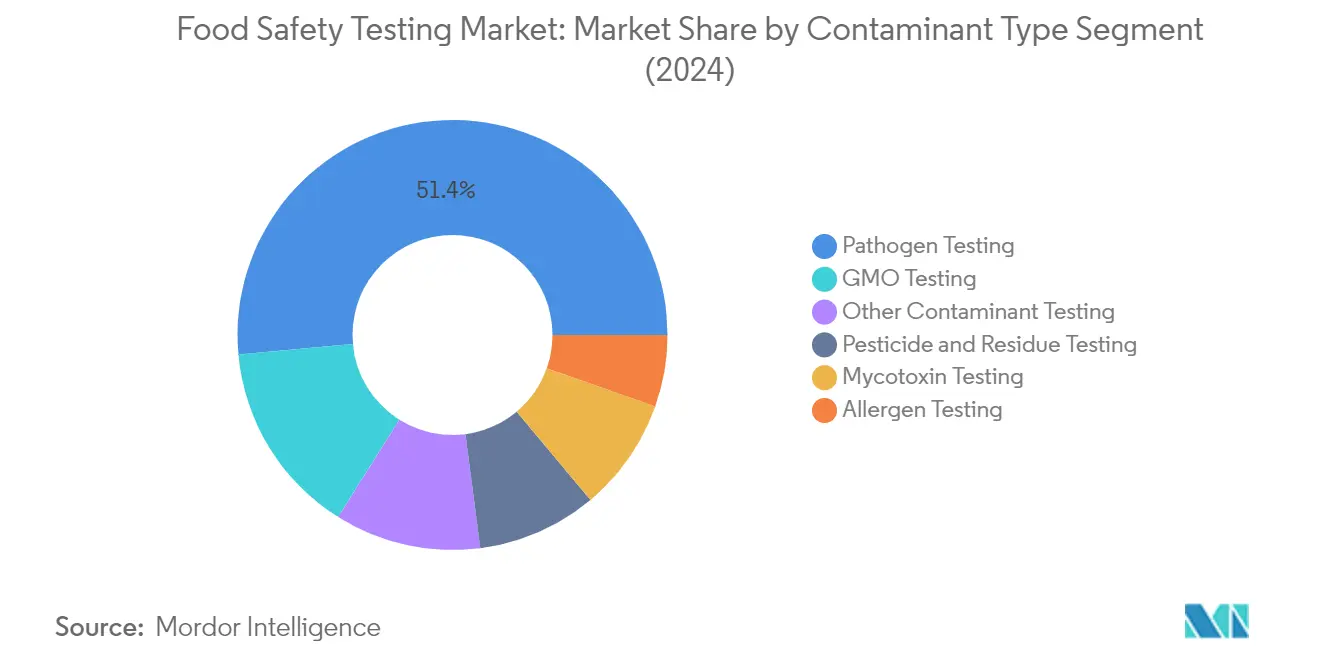
GMO Testing Segment in Food Safety Testing Market
The food GMO testing segment is experiencing the fastest growth in the food safety testing market, with an expected growth rate of approximately 8% during 2024-2029. This accelerated growth is primarily attributed to increasing awareness among consumers who prefer certified non-GMO foods due to concerns about potential adverse effects of genetically modified food products. The expansion is further driven by stringent labeling requirements for GMO products in various countries and growing demand for organic and non-GMO food products. Additionally, technological advancements in food GMO testing methods and increasing international trade of agricultural products are contributing to the segment's rapid growth.
Remaining Segments in Food Safety Testing Market
The other significant segments in the food safety testing market include pesticide and residue testing, mycotoxin testing, food allergen testing, and other contaminant testing. Pesticide and residue testing plays a crucial role in ensuring agricultural product safety, while mycotoxin testing addresses concerns related to fungal contamination in food products. The food allergen testing segment is gaining importance due to increasing food allergies and stricter labeling requirements worldwide. Other contaminant testing encompasses various specialized tests for chemical contaminants, heavy metals, and other harmful substances, providing comprehensive food chemical testing assurance across the food supply chain.
Segment Analysis: By Technology
PCR Segment in Food Safety Testing Market
The Polymerase Chain Reaction (PCR) segment dominates the global food safety testing market, commanding approximately 47% of the total market share in 2024. PCR technology has established itself as the cornerstone of food safety analysis due to its exceptional ability to provide rapid, inexpensive, and highly sensitive detection of targeted DNA segments in food samples. This technology enables food manufacturers to effectively determine both accidental and intentional adulteration by biological contaminants. The widespread adoption of PCR testing is particularly evident in applications such as detecting pathogenic microorganisms, identifying allergens, detecting genetically modified organisms (GMOs), and identifying animal species, making it an indispensable tool for ensuring food safety compliance across the global food supply chain.
Chromatography and Spectrometry Segment in Food Safety Testing Market
The Chromatography and Spectrometry segment is emerging as the fastest-growing technology in the food safety testing market, projected to grow at approximately 9% during 2024-2029. This remarkable growth is driven by the increasing demand for precise analytical methods in food safety assessment. The technology's capability to separate, identify, and quantify various chemical substances in food samples makes it particularly valuable for both qualitative and quantitative analyses. The segment's growth is further propelled by its versatility in interfacing with other analytical techniques and its crucial role in analyzing various food groups, including meat, fish, fruit, vegetables, dairy, eggs, and cereals, positioning it as a fundamental tool for comprehensive food safety analysis.
Remaining Segments in Food Safety Testing Technology
The immunoassay-based and other technology segments continue to play vital roles in the food safety testing market. Immunoassay-based testing is particularly valued for its high sensitivity and rapid detection capabilities in analyzing various food contaminants and food fraud cases. The technology's versatility in signal generation methods and the ease of automation have made it increasingly popular among food testing laboratories. Meanwhile, other technologies, including traditional culture-based methods, biosensor-based techniques, and titration-based approaches, provide complementary testing capabilities that address specific needs in food safety analysis, particularly in cases where specialized testing requirements or regulatory compliance necessitate alternative methodologies.
Segment Analysis: By Application
Food Segment in Food Safety Testing Market
The food segment continues to dominate the global food safety testing market, accounting for approximately 84% of the total market share in 2024. This substantial market share is driven by the increasing focus on ensuring food quality and safety across various food categories, including meat and poultry, dairy products, fruits and vegetables, processed foods, and crops. The segment's prominence is further reinforced by stringent regulatory requirements for food safety testing across different regions and the growing consumer awareness regarding food safety. The meat and poultry subsegment generates the maximum revenue within the food segment, highlighting the critical importance of safety testing in animal-derived food products. Additionally, the rising incidents of food contamination, growing international food trade, and increasing adoption of processed and packaged foods have significantly contributed to the segment's dominant position in the market.
Pet Food and Animal Feed Segment in Food Safety Testing Market
The pet food and animal feed segment is emerging as the fastest-growing segment in the food safety testing market, projected to grow at approximately 8% during the forecast period 2024-2029. This accelerated growth is primarily attributed to the increasing awareness about pet food safety and the rising demand for high-quality animal feed products. The segment's growth is further fueled by the implementation of stringent regulatory standards for pet food and animal feed safety testing, particularly in developed regions. The rising incidents of pet food contamination and recalls have led to an increased focus on quality control measures in the pet food industry. Moreover, the growing trend of pet humanization and the subsequent demand for premium pet food products have necessitated more rigorous safety testing protocols. The expansion of the livestock industry and the increasing awareness about the impact of feed quality on animal health and productivity are also significant factors driving the growth of this segment.
Food Safety Testing Market Geography Segment Analysis
Food Safety Testing Market in North America
North America represents a highly developed food safety testing market, characterized by stringent regulatory frameworks and advanced testing infrastructure. The region's market is primarily driven by increasing consumer awareness about food safety testing, rising incidents of foodborne illnesses, and strict government regulations regarding food quality. The United States, Canada, and Mexico form the key markets in this region, with each country having its own distinct regulatory requirements and testing protocols. The presence of major food laboratory testing companies and their extensive laboratory networks further strengthens the market position in this region.
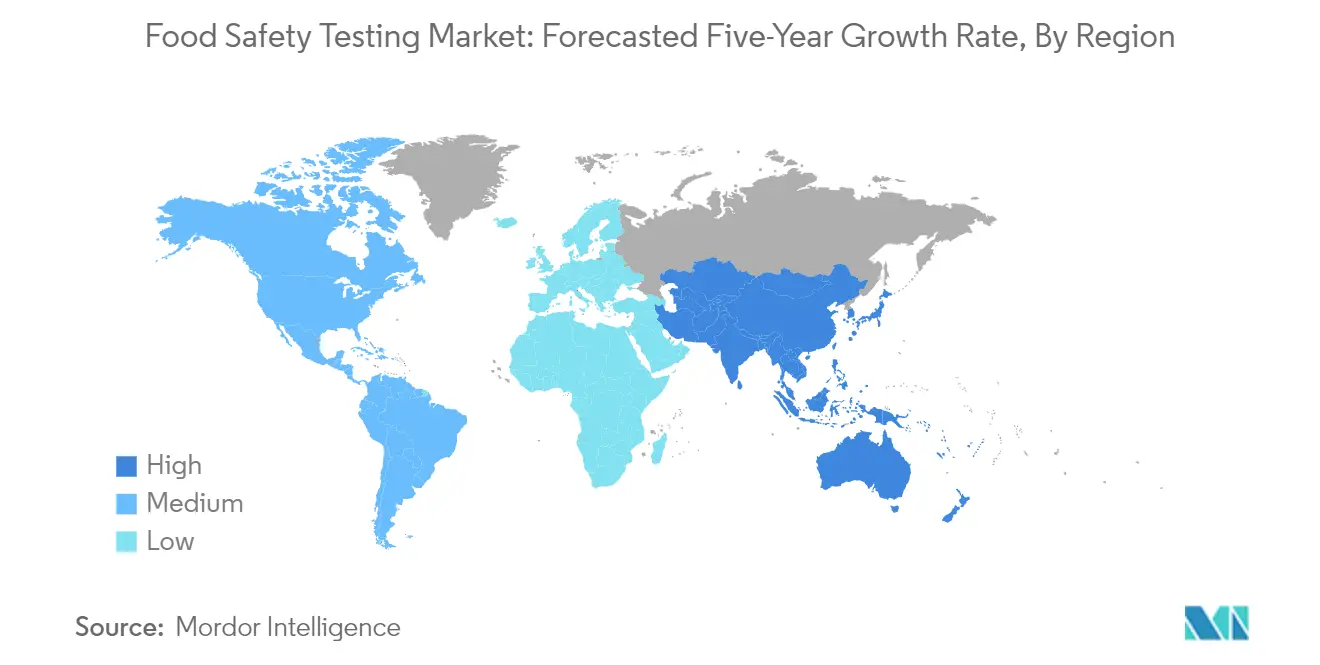
Food Safety Testing Market in the United States
The United States dominates the North American food safety testing market, holding approximately 75% of the regional market share. The country's market is characterized by comprehensive food safety testing regulations enforced by organizations like the FDA and USDA. The implementation of the Food Safety Modernization Act (FSMA) has significantly influenced testing requirements across the food supply chain. The market is particularly strong in pathogen testing, GMO testing, and allergen testing, with a growing emphasis on rapid testing technologies and advanced analytical methods.
Food Safety Testing Market in Mexico
Mexico emerges as the fastest-growing market in North America, with a projected growth rate of around 8% during 2024-2029. The growth is primarily driven by increasing food exports to the United States and Canada, necessitating compliance with international food safety testing standards. The country has been investing in modernizing its testing infrastructure and adopting advanced testing technologies. The rise in processed food production and growing awareness about food safety among domestic consumers are also contributing to market growth. Mexican authorities have been strengthening their food safety regulatory framework, particularly focusing on microbiological and chemical contamination testing.
Food Safety Testing Market in Europe
Europe maintains a sophisticated food safety testing infrastructure supported by stringent regulations and standards set by the European Food Safety Authority (EFSA). The region encompasses diverse markets including Germany, France, the United Kingdom, Spain, Russia, Italy, the Netherlands, and Belgium, each with its own specific focus areas in food safety testing. The market is characterized by high adoption of advanced testing technologies and a strong emphasis on organic and non-GMO food quality testing.
Food Safety Testing Market in Germany
Germany leads the European food safety testing market, commanding approximately 18% of the regional market share. The country's market is distinguished by its comprehensive testing requirements, particularly in areas such as allergen testing, pesticide residue analysis, and microbiological testing. German laboratories are known for their technological advancement and precision in testing methodologies, supported by strict quality control measures and accreditation standards.
Food Safety Testing Market in the Netherlands
The Netherlands demonstrates the highest growth potential in Europe, with an expected growth rate of around 8% during 2024-2029. The country's strategic position as a major food trading hub in Europe drives the demand for comprehensive food testing services. Dutch testing laboratories are particularly focused on innovative testing methods and rapid testing technologies. The country's strong focus on sustainable agriculture and food production has led to increased demand for pesticide residue testing and organic food certification.
Food Safety Testing Market in Asia-Pacific
The Asia-Pacific region represents a dynamic and rapidly evolving food safety testing market, encompassing major economies like China, India, Japan, and Australia. The market is driven by increasing food exports, growing domestic consumption of processed foods, and rising awareness about food safety testing among consumers. The region is witnessing significant investments in testing infrastructure and adoption of international food safety standards.
Food Safety Testing Market in China
China stands as the largest market for food safety testing in the Asia-Pacific region. The country has significantly strengthened its food safety regulations and testing requirements following several high-profile food safety incidents. Chinese authorities have implemented comprehensive testing protocols across the food supply chain, with particular emphasis on contaminant testing, pesticide residue analysis, and authenticity testing.
Food Safety Testing Market in India
India emerges as the fastest-growing market in the Asia-Pacific region. The country's food safety testing market is experiencing rapid transformation driven by evolving regulatory requirements and increasing consumer awareness. The Food Safety and Standards Authority of India (FSSAI) continues to strengthen testing requirements and standards, particularly focusing on dairy products, processed foods, and agricultural commodities.
Food Safety Testing Market in South America
South America's food safety testing market is characterized by a growing emphasis on export compliance and increasing domestic food safety regulations. Brazil and Argentina are the key markets in this region, with Brazil emerging as the largest market and Argentina showing the fastest growth. The region's focus on agricultural exports and increasing processed food production drives the demand for various food testing services, particularly in areas of pesticide residue testing and pathogen detection.
Food Safety Testing Market in the Middle East & Africa
The Middle East & Africa region demonstrates growing adoption of food safety testing services, primarily driven by increasing food imports and rising domestic food processing activities. South Africa represents the largest market in the region, while Saudi Arabia shows the fastest growth. The region's focus on food security and safety, particularly in imported food products, continues to drive the demand for comprehensive food laboratory testing across various food categories.
Food Safety Testing Industry Overview
Top Companies in Food Safety Testing Market
The food safety testing market is characterized by intense innovation and strategic expansion activities among key players like Eurofins Scientific, Bureau Veritas, SGS SA, and Intertek Group. Companies are consistently focusing on developing advanced testing technologies and methodologies, particularly in areas like GMO testing, allergen detection, and pathogen identification. The industry witnesses frequent launches of new testing solutions and analytical techniques to address emerging food safety testing challenges. Operational agility is demonstrated through rapid laboratory network expansion, with companies establishing new facilities in strategic locations to better serve local markets. Market leaders are actively pursuing partnerships and collaborations with technology providers and research institutions to enhance their service capabilities. Geographic expansion through both organic growth and acquisitions remains a key strategy, with particular focus on emerging markets in Asia-Pacific and Latin America.
Consolidated Market Led By Global Players
The food safety testing market exhibits a relatively consolidated structure dominated by large multinational corporations with extensive global laboratory networks. These major players leverage their comprehensive service portfolios, advanced technological capabilities, and strong brand recognition to maintain their market positions. The landscape is characterized by a mix of pure-play testing companies and diversified technical service providers, with the latter offering food testing services as part of their broader portfolio of inspection and certification services. Market consolidation continues through strategic acquisitions, with larger players regularly acquiring regional laboratories and specialized testing facilities to expand their geographic presence and technical capabilities.
The market demonstrates high barriers to entry due to significant capital requirements, stringent accreditation needs, and the importance of established client relationships. Regional and local players maintain strong positions in specific geographic markets through their understanding of local regulations and customer needs. The industry witnesses regular merger and acquisition activities, particularly targeting specialized laboratories with unique testing capabilities or strong regional presence. Joint ventures and strategic partnerships are common, especially in emerging markets where local expertise is crucial for market penetration.
Innovation and Compliance Drive Market Success
Success in the food safety testing market increasingly depends on the ability to offer comprehensive testing solutions while maintaining operational efficiency and technical excellence. Incumbent players must continuously invest in new testing technologies and automation to maintain their competitive edge, while also expanding their service portfolios to address emerging food safety concerns. Building strong relationships with food manufacturers and regulatory bodies, maintaining high-quality standards, and offering value-added services like consulting and training are crucial for market leadership. Companies need to balance geographic expansion with operational efficiency while maintaining accreditation standards across their laboratory networks.
For new entrants and smaller players, success lies in identifying and focusing on specific market niches or geographic regions where they can build expertise and reputation. Developing specialized testing capabilities for emerging contaminants or new food categories can provide competitive advantages. The increasing focus on food safety regulations and consumer awareness creates opportunities for companies that can offer innovative, cost-effective food testing services. Building technological capabilities through strategic partnerships, investing in automation to improve efficiency, and maintaining strong local market relationships are essential strategies for gaining market share. The ability to adapt to changing regulatory requirements and emerging food safety concerns while maintaining cost competitiveness will be crucial for long-term success.
Food Safety Testing Market Leaders
-
NSF International
-
SGS Group
-
Bureau Veritas
-
Eurofins Scientific SE
-
Intertek Group PLC
- *Disclaimer: Major Players sorted in no particular order
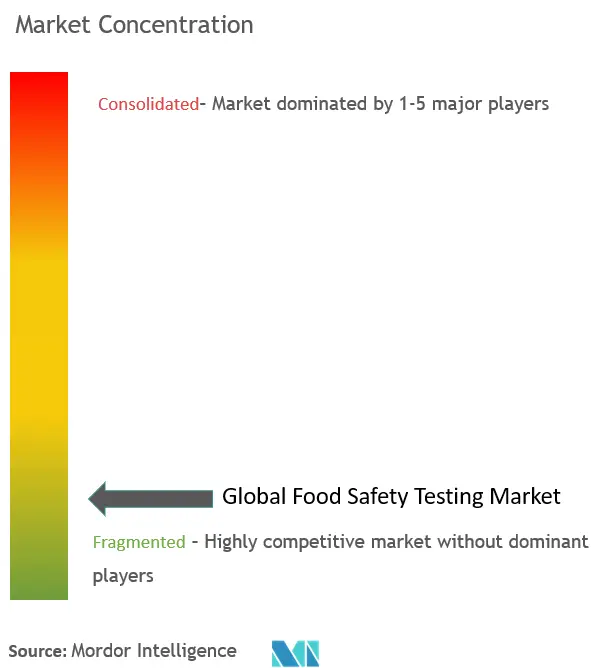
Food Safety Testing Market News
- July 2022: SGS launched a new food analysis laboratory in Mexico. The new Naucalpan laboratory will support the Mexican food industry, assisting organizations with quality control and regulatory compliance.
- May 2022: Bureau Veritas, a provider of laboratory testing, inspection, and certification services, announced the opening of its third US microbiology laboratory, based in Reno, Nevada. The facility planned to conduct rapid pathogen testing and microbiology indicator analyses for the agri-food sector.
- April 2022: Mérieux NutriSciences, a global leader in food safety, quality, and sustainability, acquired Hortec Pty Ltd (Hortec) in South Africa and Laboratorios Bromatológicos Araba SA (Aralab) in Spain. With these new acquisitions, Mérieux NutriSciences is furthering its strategic objectives and strengthening its capabilities by entering the South African pesticide market and reinforcing its geographical presence in Spain.
Food Safety Testing Market Report - Table of Contents
1. INTRODUCTION
- 1.1 Study Assumptions and Market Definition
- 1.2 Scope of the Study
2. RESEARCH METHODOLOGY
3. EXECUTIVE SUMMARY
4. MARKET DYNAMICS
- 4.1 Market Drivers
- 4.2 Market Restraints
-
4.3 Porter's Five Forces Analysis
- 4.3.1 Threat of New Entrants
- 4.3.2 Bargaining Power of Buyers/Consumers
- 4.3.3 Bargaining Power of Suppliers
- 4.3.4 Threat of Substitute Products
- 4.3.5 Intensity of Competitive Rivalry
5. MARKET SEGMENTATION
-
5.1 Contaminant Testing
- 5.1.1 Pathogen Testing
- 5.1.2 Pesticide and Residue Testing
- 5.1.3 Mycotoxin Testing
- 5.1.4 GMO Testing
- 5.1.5 Allergen Testing
- 5.1.6 Other Contaminant Testing
-
5.2 Technology
- 5.2.1 Polymerase Chain Reaction (PCR)
- 5.2.2 Immunoassay-based
- 5.2.3 Chromatography and Spectrometry
- 5.2.3.1 HPLC Based
- 5.2.3.2 LC-MS/MS-Based
- 5.2.3.3 Other Chromatography and Spectrometry
- 5.2.4 Other Technologies
-
5.3 Application
- 5.3.1 Animal Feed and Pet Food
- 5.3.2 Food
- 5.3.2.1 Meat and Poultry
- 5.3.2.2 Dairy
- 5.3.2.3 Fruits and Vegetables
- 5.3.2.4 Processed Food
- 5.3.2.4.1 Baby Food
- 5.3.2.4.2 Bakery Products
- 5.3.2.4.3 Savory and Sweet Snacks
- 5.3.2.4.4 Dietary Supplements
- 5.3.2.5 Crops
- 5.3.2.6 Other Foods
-
5.4 Geography
- 5.4.1 North America
- 5.4.1.1 United States
- 5.4.1.2 Canada
- 5.4.1.3 Mexico
- 5.4.1.4 Rest of North America
- 5.4.2 Europe
- 5.4.2.1 United Kingdom
- 5.4.2.2 Germany
- 5.4.2.3 France
- 5.4.2.4 Russia
- 5.4.2.5 Italy
- 5.4.2.6 Spain
- 5.4.2.7 Rest of Europe
- 5.4.3 Asia-Pacific
- 5.4.3.1 India
- 5.4.3.2 China
- 5.4.3.3 Japan
- 5.4.3.4 Australia
- 5.4.3.5 Rest of Asia-Pacific
- 5.4.4 South America
- 5.4.4.1 Brazil
- 5.4.4.2 Argentina
- 5.4.4.3 Rest of South America
- 5.4.5 Middle East & Africa
- 5.4.5.1 South Africa
- 5.4.5.2 Saudi Arabia
- 5.4.5.3 Rest of Middle East & Africa
6. COMPETITIVE LANDSCAPE
- 6.1 Most Adopted Strategies
- 6.2 Market Share Analysis
-
6.3 Company Profiles
- 6.3.1 NSF International
- 6.3.2 SGS GROUP
- 6.3.3 Bureau Veritas
- 6.3.4 Eurofins Scientific
- 6.3.5 Intertek Group PLC
- 6.3.6 Merieux Nutrisciences
- 6.3.7 TUV SUD
- 6.3.8 ALS Limited
- 6.3.9 Asurequality Limited
- 6.3.10 UL LLC
- *List Not Exhaustive
7. MARKET OPPORTUNITIES AND FUTURE TRENDS
Food Safety Testing Industry Segmentation
Food safety testing is a scientific procedure that assesses food safety based on its microbiological, physical, or chemical composition. The food business has devised a set of food safety testing protocols to ensure the safety of the food supply. The global food safety testing market (henceforth, referred to as the market studied) is segmented by contaminant testing, technology, application, and geography. By contaminant testing, the market is segmented into pathogen testing, pesticide and residue testing, mycotoxin testing, GMO testing, allergen testing, and other containment testing. By technology, the market is segmented into immunoassay-based, chromatography and spectrometry (which is further segmented into HPLC-based, LC-MS/MS-based, and other chromatography and spectrometry), and other technologies. Based on application, the market studied is segmented into animal feed and pet food, and food. The food segment is further sub-segmented into meat and poultry, dairy, fruits and vegetables, processed food (which is further segmented into baby food, bakery products, savory and sweet snacks, and dietary supplements), crops, and other foods. It provides an analysis of emerging and established economies across the world, comprising North America, Europe, South America, Asia-Pacific, and Middle East and Africa. For each segment, the market sizing and forecasts have been provided based on value (in USD million).
| Contaminant Testing | Pathogen Testing | |||
| Pesticide and Residue Testing | ||||
| Mycotoxin Testing | ||||
| GMO Testing | ||||
| Allergen Testing | ||||
| Other Contaminant Testing | ||||
| Technology | Polymerase Chain Reaction (PCR) | |||
| Immunoassay-based | ||||
| Chromatography and Spectrometry | HPLC Based | |||
| LC-MS/MS-Based | ||||
| Other Chromatography and Spectrometry | ||||
| Other Technologies | ||||
| Application | Animal Feed and Pet Food | |||
| Food | Meat and Poultry | |||
| Dairy | ||||
| Fruits and Vegetables | ||||
| Processed Food | Baby Food | |||
| Bakery Products | ||||
| Savory and Sweet Snacks | ||||
| Dietary Supplements | ||||
| Crops | ||||
| Other Foods | ||||
| Geography | North America | United States | ||
| Canada | ||||
| Mexico | ||||
| Rest of North America | ||||
| Europe | United Kingdom | |||
| Germany | ||||
| France | ||||
| Russia | ||||
| Italy | ||||
| Spain | ||||
| Rest of Europe | ||||
| Asia-Pacific | India | |||
| China | ||||
| Japan | ||||
| Australia | ||||
| Rest of Asia-Pacific | ||||
| South America | Brazil | |||
| Argentina | ||||
| Rest of South America | ||||
| Middle East & Africa | South Africa | |||
| Saudi Arabia | ||||
| Rest of Middle East & Africa | ||||
Food Safety Testing Market Research FAQs
How big is the Food Safety Testing Market?
The Food Safety Testing Market size is expected to reach USD 25.33 billion in 2025 and grow at a CAGR of 7.43% to reach USD 36.25 billion by 2030.
What is the current Food Safety Testing Market size?
In 2025, the Food Safety Testing Market size is expected to reach USD 25.33 billion.
Who are the key players in Food Safety Testing Market?
NSF International, SGS Group, Bureau Veritas, Eurofins Scientific SE and Intertek Group PLC are the major companies operating in the Food Safety Testing Market.
Which is the fastest growing region in Food Safety Testing Market?
Middle East and Africa is estimated to grow at the highest CAGR over the forecast period (2025-2030).
Which region has the biggest share in Food Safety Testing Market?
In 2025, the Europe accounts for the largest market share in Food Safety Testing Market.
What years does this Food Safety Testing Market cover, and what was the market size in 2024?
In 2024, the Food Safety Testing Market size was estimated at USD 23.45 billion. The report covers the Food Safety Testing Market historical market size for years: 2019, 2020, 2021, 2022, 2023 and 2024. The report also forecasts the Food Safety Testing Market size for years: 2025, 2026, 2027, 2028, 2029 and 2030.
Our Best Selling Reports
Food Safety Testing Market Research
Mordor Intelligence provides comprehensive insights into the food safety testing industry through detailed food analysis and market evaluation. Our expertise covers the full range of food laboratory testing methodologies. This includes food microbiological testing, food allergen testing, and food quality assurance protocols. The report offers in-depth coverage of food diagnostics trends and food hygiene testing standards. It also explores emerging food testing services, all available in an easy-to-read report PDF format for immediate download.
Stakeholders gain from our thorough analysis of food quality testing methodologies. This includes detailed assessments of food contamination testing, food chemical testing, and food pathogen testing procedures. The report examines food authenticity testing protocols and food bacteria testing developments. It also covers advances in food pesticide testing and food GMO testing technologies. Our comprehensive food diagnostics market analysis aids businesses in optimizing their testing protocols while ensuring compliance with global safety standards. The report delivers actionable insights for companies involved in food microbiology testing, supporting strategic decision-making across the industry.

